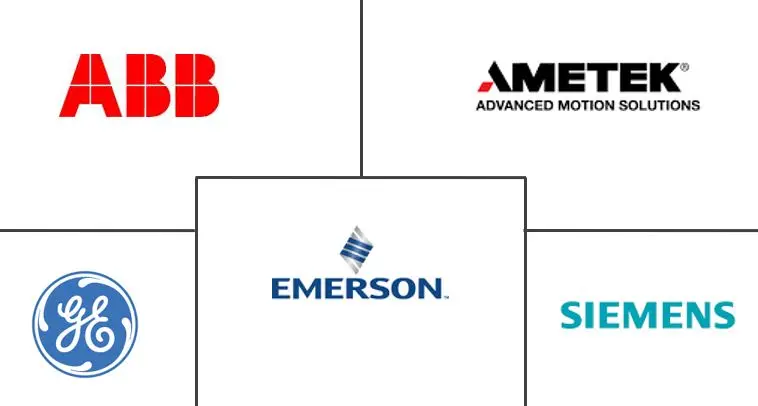Emission Monitoring Systems Market Size and Share
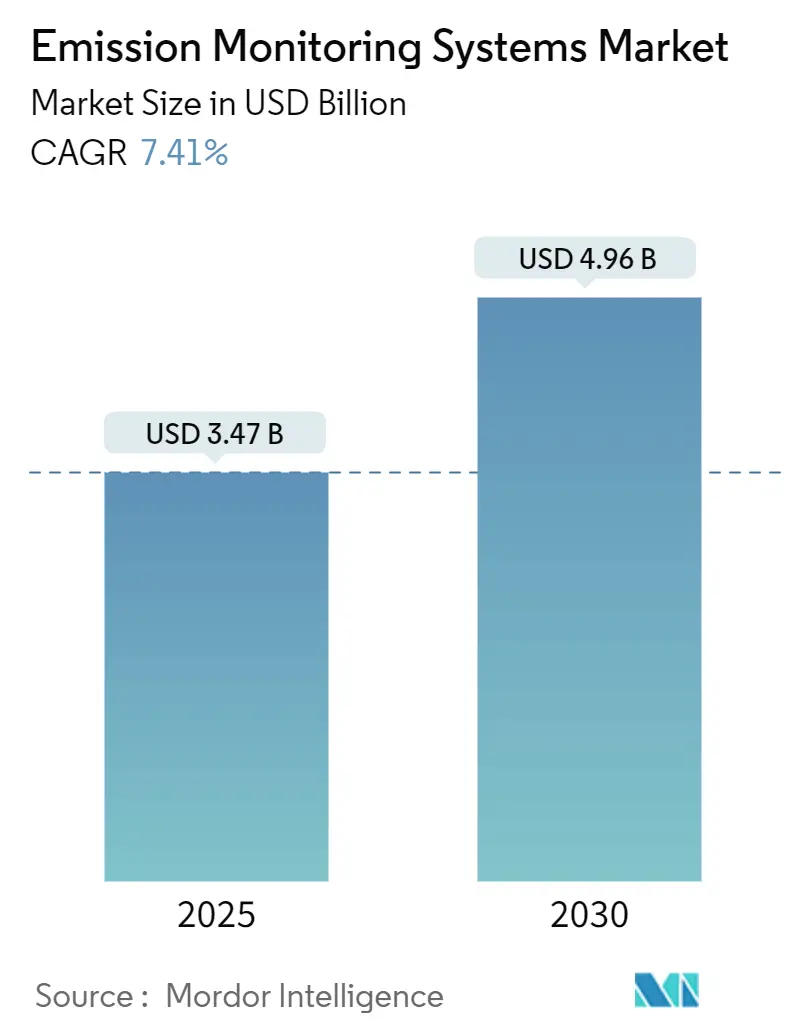
Emission Monitoring Systems Market Analysis by Mordor Intelligence
The emission monitoring systems market is valued at USD 3.47 billion in 2025 and is forecast to reach USD 4.96 billion by 2030, advancing at a 7.41% CAGR. Stricter air-pollution rules and the direct monetization of carbon under the EU Emissions Trading System Phase IV are raising demand for higher-accuracy stack monitors, while the shift toward hybrid continuous–predictive architectures is redefining vendor strategies. Hardware still generates the largest revenue stream, holding 46% of 2024 sales, yet services are expanding fastest at a 7.7% CAGR as users seek calibration, certification, and data-management support. North America leads in installed base, but Asia Pacific records the highest 10% regional growth as China and India impose new plant-level limits. In-situ laser analyzers, particularly TDLS, are rapidly displacing extractive systems in waste-to-energy plants, lowering lifecycle outlays by roughly 30%. Simultaneously, AI-enabled software modules are turning compliance data into predictive-maintenance and process-optimization tools that trim operating costs by 15-20%.
Key Report Takeaways
- By system type, Continuous Emission Monitoring Systems retained 71% of the emission monitoring systems market share in 2024; Predictive Emission Monitoring Systems are projected to grow at an 8.4% CAGR through 2030.
- By component, hardware dominated with 46% revenue share in 2024, while services represent the fastest expansion at a 7.7% CAGR to 2030.
- By monitoring technology, extractive solutions held 52% of the emission monitoring systems market size in 2024; in-situ laser technologies are forecast to rise at a 10.2% CAGR between 2025-2030.
- By end-user industry, power generation captured 34% of the emission monitoring systems market size in 2024, whereas waste-to-energy facilities are advancing at a 9.8% CAGR to 2030.
- By geography, North America led with a 39% revenue share in 2024, while Asia Pacific is set to post the highest 10% CAGR through 2030.
Global Emission Monitoring Systems Market Trends and Insights
Drivers Impact Analysis
| Driver | (~) % Impact on CAGR Forecast | Geographic Relevance | Impact Timeline |
|---|---|---|---|
| Transition from CAPEX-heavy CEMS to Hybrid CEMS-PEMS Architectures | +1.2% | Global, with early adoption in North America and Europe | Medium term (2-4 years) |
| Mandatory EU-ETS Phase-IV Carbon Pricing Driving Stack-Level Monitoring | +1.8% | Europe, with spillover effects in countries with EU trade agreements | Short term (≤ 2 years) |
| Inflation Reduction Act Tax-Credit Verification Creating Surge in U.S. Power-Plant CEMS Retrofits | +1.3% | North America, primarily U.S. utility sector | Short term (≤ 2 years) |
| In-situ Laser-Based Sensors Cutting Lifecycle Cost by 30% in APAC Waste-to-Energy Plants | +0.9% | Asia Pacific, particularly China, Japan, and South Korea | Medium term (2-4 years) |
| National Clean Air Programme Accelerating Coal-Fired CEMS Roll-outs | +1.1% | India, with influence on South Asian markets | Medium term (2-4 years) |
| IMO 2023 EEXI & CII Rules Triggering Ship-board SEMS Installations | +0.7% | Global maritime sector, with concentration in major shipping hubs | Long term (≥ 4 years) |
| Source: Mordor Intelligence | |||
Transition from CAPEX-heavy CEMS to Hybrid CEMS–PEMS Architectures
Hybrid configurations blend direct readings from CEMS hardware with software-based emission models, lowering upfront expenditure by 25-30% while keeping error rates below 3% against reference instruments.[1]Bonavita, Nunzio, and Federico Callero. "ABB - Model Based Emission Monitoring." abb.com Early adopters in U.S. refineries and combined-cycle gas plants now treat predictive modules as a compliance-accepted alternative for secondary pollutants after U.S. EPA approval. Global platform vendors embed machine-learning algorithms that auto-calibrate models in real time, shrinking validation cycles. As cloud hosting removes local IT overhead, software pricing is falling, opening the hybrid option to mid-sized facilities. Analysts expect this configuration to represent roughly one-quarter of all new emission monitoring systems market installations by 2027.
Mandatory EU-ETS Phase IV Carbon Pricing Driving Stack-Level Monitoring
Allowance prices above EUR 80 per tonne in 2025 have turned emissions data into a line-item financial variable.[2]European Commission, “WK 2134/2025 INIT,” consilium.europa.eu Operators in power, cement, and waste management have added high-precision analyzers that improve accuracy by 2-3 percentage points versus prior models, minimizing over-purchasing of carbon credits. Expansion of scope to maritime and small industrial sites has boosted new system orders across Eastern Europe, where installations jumped 35% since 2023. Plants now integrate monitors directly with process-control loops to throttle output against live carbon costs. Vendors able to pair monitoring hardware with automated trading dashboards have gained share in the emission monitoring systems market.
Inflation Reduction Act Tax-Credit Verification Creating Surge in U.S. Power-Plant CEMS Retrofits
U.S. utilities pursuing production credits of up to USD 30 per MWh must certify emissions with higher-fidelity instruments that capture multi-gas data.[3]U.S. Energy Information Administration, “Capital Cost and Performance Characteristics for Utility-Scale Electric Power Generating Technologies,” eia.gov The verification push drove a 42% jump in retrofit projects since 2023, especially at units adopting hydrogen co-firing or carbon-capture add-ons. Many legacy analyzers installed before 2010 lack the precision window demanded by the Internal Revenue Service, forcing replacements. Providers offering turnkey packages—hardware, cloud reporting, and audit-ready data trails—command premium pricing but accelerate payback for plant owners seeking rapid tax-credit qualification. Remote diagnostics embedded in new units also shrink unplanned downtime, a further incentive.
In-situ Laser-Based Sensors Cutting Lifecycle Cost by 30% in APAC Waste-to-Energy Plants
TDLAS and Quantum Cascade Laser devices measure gases directly in the stack, eliminating sample-conditioning hardware and trimming maintenance budgets by roughly one-third.[4]Endress+Hauser AG, “Tunable Diode Laser Absorption Spectroscopy (TDLAS),” endress.com Uptime levels above 98% in Japanese and Chinese incinerators underline performance resilience in high-dust flue gas. Lower consumables use and fewer calibration gas bottles strengthen the total-cost case even with a higher initial outlay. Asia Pacific waste-to-energy capacity is rising 15% annually, so demand for compact, high-temperature-ready laser analyzers remains robust. Domestic Chinese OEMs are accelerating local production, fueling competitive pricing and broader uptake across the emission monitoring systems market.
Restraints Impact Analysis
| Restraint | (~) % Impact on CAGR Forecast | Geographic Relevance | Impact Timeline |
|---|---|---|---|
| Scarcity of TÜV & MCERTS-Certified Technicians Delaying European Commissioning | -0.7% | Europe, particularly Eastern European countries | Medium term (2-4 years) |
| High Humidity Bias in Tropical Regions Raising False-Compliance Risk | -0.5% | Southeast Asia, Latin America, and tropical Africa | Short term (≤ 2 years) |
| Legacy DCS–DAQ Inter-operability Gaps Inflating Retrofit Costs in U.S. Utilities | -0.8% | North America, primarily U.S. power generation sector | Medium term (2-4 years) |
| Capital Lock-In from Long-Term CEMS Leasing Models Hindering PEMS Adoption | -0.6% | Middle East and Africa | Long term (≥ 4 years) |
| Source: Mordor Intelligence | |||
Scarcity of TÜV & MCERTS-Certified Technicians Delaying European Commissioning
Compliance in Europe obliges on-site audits by technicians accredited under TÜV or MCERTS frameworks. A 40% workforce shortfall has extended average project start-ups by up to six months, particularly in Poland, Romania, and Bulgaria. Hourly service rates have escalated 25-30% since 2023, pushing users toward vendors with in-house service arms. OEMs respond with remote-assistance toolkits that guide local staff through calibration sequences via augmented-reality headsets. Despite these work-arounds, the technician bottleneck trims near-term growth for the emission monitoring systems market until training pipelines expand.
Legacy DCS–DAQ Inter-operability Gaps Inflating Retrofit Costs in U.S. Utilities
Roughly two-thirds of American generating units still rely on control platforms older than 15 years. Modern CEMS often speak Ethernet-based protocols, whereas vintage systems use serial or proprietary links, adding interface hardware and engineering labor that drives retrofit costs 30-45% higher than greenfield installs. Edge gateways that bridge old and new networks are gaining traction, yet custom coding and cyber-security vetting remain unavoidable. Some coal operators facing potential retirement hesitate to commit fresh capital, moderating replacement volumes in the emission monitoring systems market over the medium horizon.
Segment Analysis
By System Type: Hybrid setups realign cost and compliance objectives
The segment opened 2024 with CEMS owning 71% of revenue thanks to universal regulatory acceptance. However, PEMS is outpacing at an 8.4% CAGR as cloud compute charges fall and regulators endorse predictive algorithms. The emission monitoring systems market size linked to hybrid deployments is projected to cross USD 1 billion by 2027, reflecting steadily rising adoption where processes run under steady-state conditions. Oil refineries, gas turbines, and petrochemical crackers see tight correlations between temperature, O₂, and pollutant outputs, making them prime candidates. Vendors that package turnkey data-science support gain leverage, because many plant engineers lack modeling expertise. Incremental software subscriptions also give suppliers annuity revenue, shifting away from lumpy hardware sales.
CEMS remains irreplaceable for primary pollutants such as SO₂ and particulate matter where laws demand direct readings. As a result, hybrid configurations that pair a compact analyzer for critical gases with PEMS for secondary streams dominate new bids. The approach lets operators balance compliance rigor and budget, preserving CEMS integrity while harvesting PEMS cost savings. Within this model, the emission monitoring systems market share of pure predictive installations is unlikely to top 10% by 2030, yet hybrid value will mount steadily as AI tools improve and field data builds confidence.
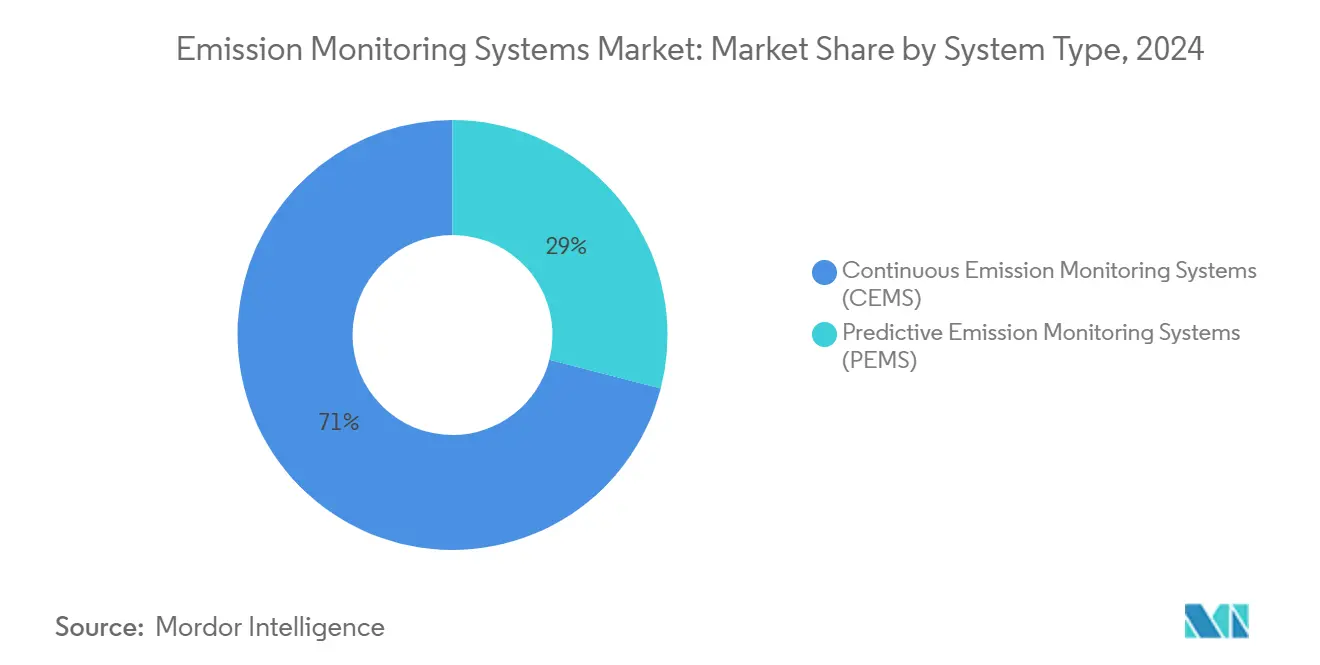
Note: Segment shares of all individual segments available upon report purchase
By Component: Service revenue accelerates amid regulatory complexity
Gas analyzers, flow sensors, and probes generated 46% of global turnover in 2024, led by multi-component FTIR and TDLS instruments that command premium pricing in cement, steel, and waste-to-energy. Nevertheless, recurring service contracts—calibration, certification, and data validation—now advance at a 7.7% CAGR. New trading schemes such as national carbon markets in Canada and South Korea raise the stakes for data accuracy, prompting annual or semi-annual audits. End-users lacking internal metrology teams outsource compliance assurance, making service specialists pivotal across the emission monitoring systems market.
Cloud-native software modules add another growth lever. Suppliers bundle automated compliance reports that map directly to EU or EPA templates, cutting administrative workload. Subscription revenue is rising 18% annually, reshaping financial models. Some OEMs have introduced emissions-monitoring-as-a-service plans that combine hardware leases with full-scope maintenance, smoothing customer cash out-flows. This recurring model should gradually dilute lump-sum hardware dependence and diversify income streams in the emission monitoring systems industry.
By Monitoring Technology: In-situ lasers disrupt extractive incumbency
Extractive designs held 52% share in 2024, valued for multi-gas versatility and deep certification history. Yet in-situ laser systems post a 10.2% CAGR through 2030, riding advances in optics that withstand corrosive and dusty flows. Plants save on chillers, pumps, and filters normally required for sample conditioning, reducing annual spend by around 35%. TDLS units also deliver millisecond response time, enabling tighter combustion control. Waste-to-energy and cement customers note uptime gains that offset higher capex within two years.
Cold-dry extractive analyzers still dominate in multiparameter tasks where regulators stipulate identical sampling lines for all pollutants. Dilution-based approaches persist in petrochemical fence-line monitoring, though rising optical coverage is eroding demand. Over the coming decade, the emission monitoring systems market size for hybrid solutions that pair an in-situ laser for key gases with a compact extractive rack for metals or dioxins will widen, especially in space-constrained retrofits where analyzer shelters are impractical.
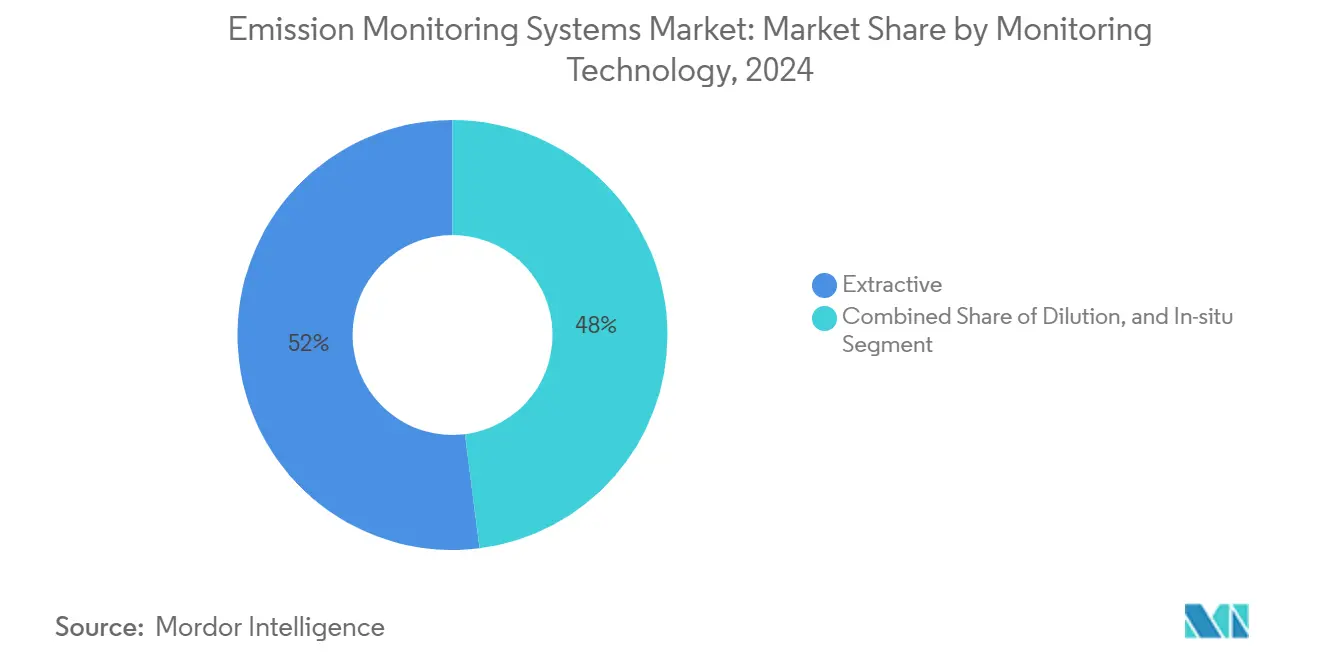
Note: Segment shares of all individual segments available upon report purchase
By End-User Industry: Waste-to-energy becomes the innovation test bed
Power producers commanded 34% revenue in 2024, yet growth is modest as many coal stations near retirement. Combined-cycle gas turbines add volume in regions phasing out coal, but their comparatively low emissions limit analyzer complexity. In contrast, waste-to-energy plants expand at a 9.8% CAGR, pushing innovation in multi-pollutant monitoring that covers HF, HCl, dioxins, and heavy metals. Operators value compact laser analyzers that outlast corrosive flue gas and deliver near-continuous uptime, aligning with public-facing transparency mandates.
Maritime applications are emerging after IMO rules took effect in 2023. Roughly 9,000 vessels-15% of the world fleet-now carry some form of ship-borne emissions monitor. Space, vibration, and salt-spray constraints drive demand for rugged, miniaturized analyzers. Oil-and-gas midstream and downstream facilities remain core buyers, yet incremental growth resides in petrochemical tank farms where vapors previously escaped measurement. The emission monitoring systems market share associated with these specialized niches should rise as regulators close loopholes.
Geography Analysis
North America headed the 2024 rankings with 39% revenue, anchored by roughly 15,000 installed CEMS units across power and refining. Inflation Reduction Act incentives prompt utilities to modernize analyzers, while Canada’s output-based pricing system spreads monitoring into mid-size manufacturing. Retrofit projects dominate order books because many units installed before 2015 reach end-of-life. Integration with cloud dashboards that link compliance data to maintenance planning is now standard practice, and this digital overlay influences most competitive bids.
Asia Pacific is the fastest-growing region at a 10% CAGR. China’s 14th Five-Year Plan compels around 80,000 plants to install monitors, often leapfrogging directly to in-situ lasers. India’s National Clean Air Programme mandates continuous stacks at more than 200 coal stations by 2026, compressing buying cycles. Advanced analyzer vendors partner with local system integrators to navigate procurement rules and service coverage gaps. Japan and South Korea already operate mature fleets but continue to upgrade to TDLS and quantum-cascade platforms, especially in waste-to-energy. Southeast Asia mirrors Chinese standards; Vietnam and Indonesia published guidelines modeled on GB standards in 2024, widening the install base for the emission monitoring systems market.
Europe represents 25% of global value, uniquely shaped by carbon-price exposure under the EU-ETS, which elevates data-quality requirements. Eastern-member expansion drives first-install volumes, while Western-EU users focus on uptime and cost-of-ownership gains. Service revenue is proportionally higher because annual calibrations and parallel-sampling tests are mandatory. The Middle East and Africa are nascent but promising: Saudi Arabia’s Vision 2030 ties emissions targets to industrial diversification, and South Africa’s carbon tax accelerates monitoring adoption in mining and power. Harsh-environment resilience-high dust, heat, and salinity-forms a technical differentiator for vendors chasing these frontier opportunities
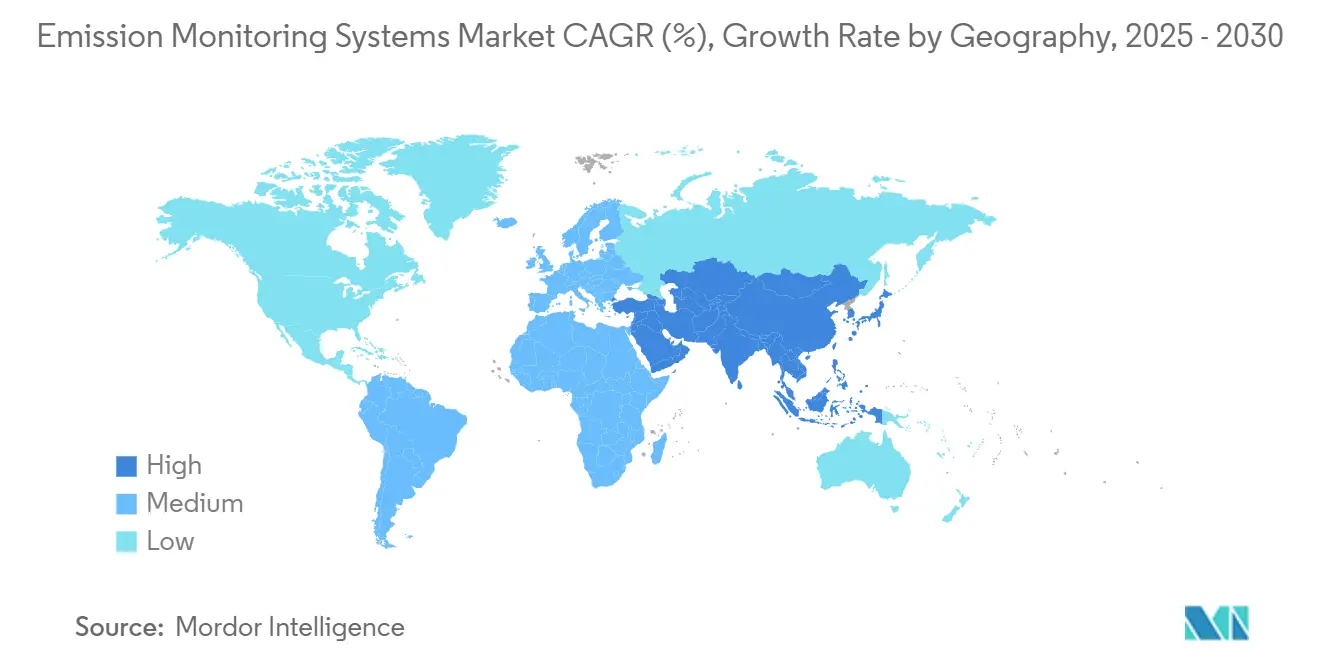
Competitive Landscape
The emission monitoring systems market is moderately concentrated; the top five suppliers-ABB, Siemens, Emerson, Thermo Fisher Scientific, and AMETEK-collectively held about 45% of 2024 revenue. Their strength stems from combining analyzers with broader automation suites, letting customers align environmental compliance with process control. This integration edge is critical as end-users aim to mine emissions data for efficiency improvements. Platform players deepened portfolios through targeted acquisitions, such as Emerson’s 2025 purchase of ENVEA, which added optical-monitoring and ambient-air lines.
Pure-play companies counter by specializing in high-performance niches: Teledyne leverages quantum-cascade laser IP for ultratrace measurement, while Fuji Electric and HORIBA dominate domestic Japanese and Chinese markets through localized support. Competition now extends beyond hardware: Microsoft’s alliance with Siemens embeds Azure IoT analytics into compliance workflows, illustrating how software giants can reshape value capture. Meanwhile, marine-sector specialists develop compact monitors that satisfy class-society approvals, an arena still underserved by the mainstream automation majors.
White-space remains for simplified, low-maintenance packages aimed at small and medium enterprises that newly fall under emissions rules. Subscription-based “monitoring-as-a-service” models, pioneered by Honeywell in late 2024, lower capital barriers and lock customers into multi-year contracts. As AI modules mature, differentiation will hinge on predictive insights rather than sensor count. These dynamics are expected to keep M&A active as incumbents seek data-science talent and software IP to defend share in a rapidly digitizing emission monitoring systems market.
Emission Monitoring Systems Industry Leaders
-
ABB Ltd.
-
AMETEK, Inc.
-
Emerson Electric Co.
-
General Electric Company
-
Siemens AG
- *Disclaimer: Major Players sorted in no particular order
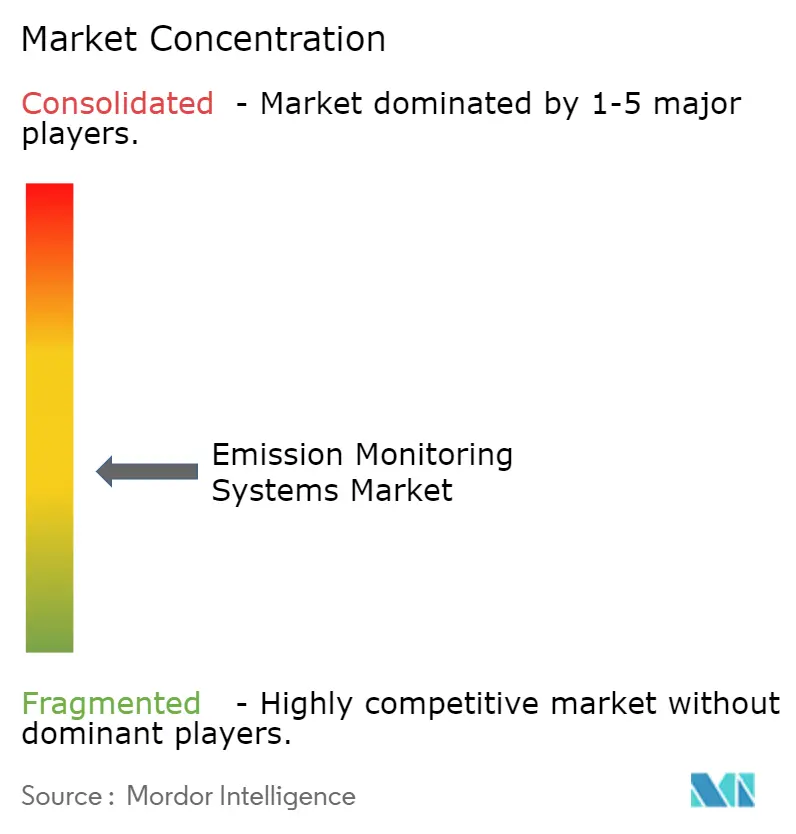
Recent Industry Developments
- March 2025: ABB launched the ACF5000 FTIR analyzer with 12-month maintenance intervals and built-in machine-learning calibration.
- March 2025: Siemens and Microsoft formed a partnership to deliver cloud-based emissions-monitoring and carbon-accounting tools on Azure IoT.
- February 2025: Emerson acquired ENVEA Global SAS for USD 780 million, expanding optical and ambient-air monitoring capabilities.
- January 2025: Thermo Fisher Scientific introduced the Mercury Freedom System with <0.5 µg/m³ detection limits.
- December 2024: SICK AG released the DUSTHUNTER 3 laser particulate monitor featuring self-alignment and 95% less maintenance than opacity meters
Research Methodology Framework and Report Scope
Market Definitions and Key Coverage
Our study defines the emission monitoring systems market as sales of fixed-site instrumentation, data loggers, and software that continuously or predictively capture stack-gas parameters (SO₂, NOx, CO, CO₂, O₂, flow, opacity) to evidence compliance with air-quality regulations across industrial point sources. We track Continuous (CEMS) and Predictive (PEMS) solutions installed on boilers, kilns, furnaces, reactors, and flares worldwide.
Scope exclusion: portable hand-held testers and satellite-based ambient sensing are outside this remit.
Segmentation Overview
- By System Type
- Continuous Emission Monitoring Systems (CEMS)
- Predictive Emission Monitoring Systems (PEMS)
- By Component
- Hardware
- Gas Analyzers
- Flow and Opacity Monitors
- Data Acquisition Systems (DAS)
- Software
- Stand-alone
- Cloud-Hosted
- Services
- Installation and Deployment
- Calibration and Certification
- Support and Maintenance
- Hardware
- By Monitoring Technology
- Extractive
- Hot-Wet
- Cold-Dry
- Dilution
- In-situ
- Tunable Diode Laser Spectroscopy (TDLS)
- Extractive
- By End-User Industry
- Power Generation
- Coal-Fired
- Combined-cycle Gas Turbines
- Oil and Gas
- Upstream
- Midstream
- Downstream and Refineries
- Metals and Mining
- Chemicals and Petrochemicals
- Pharmaceuticals
- Cement and Aggregates
- Pulp and Paper
- Waste-to-Energy and Incineration
- Maritime (Ship-board)
- Power Generation
- By Geography
- North America
- United States
- Canada
- Mexico
- Europe
- Germany
- United Kingdom
- France
- Italy
- Spain
- Rest of Europe
- Asia-Pacific
- China
- Japan
- South Korea
- India
- South East Asia
- Rest of Asia-Pacific
- South America
- Brazil
- Rest of South America
- Middle East and Africa
- Middle East
- United Arab Emirates
- Saudi Arabia
- Rest of Middle East
- Africa
- South Africa
- Rest of Africa
- Middle East
- North America
Detailed Research Methodology and Data Validation
Primary Research
Mordor analysts interviewed stack-testing contractors, CEMS integrators, refinery EHS managers, and regional regulators in North America, Europe, and Asia. These dialogues clarified real-world replacement cycles, service mark-ups, and regulatory grace periods, letting us reconcile desk-based volume estimates with field reality.
Desk Research
We compiled public data from regulators such as the US EPA's Air Markets Program, the EU Industrial Emissions Directive registries, and India's CPCB OCEMS dashboard, alongside trade bodies like the World Cement Association and the International Energy Agency. Company 10-Ks, import-export manifests (Volza), patent families (Questel), and peer-reviewed journals on tunable-diode-laser analyzers rounded out baseline evidence. Our team also tapped Dow Jones Factiva to track tender awards and plant retrofits. The examples cited are illustrative; many other sources reinforced each datapoint.
Market-Sizing & Forecasting
We began with a top-down construct that rebuilt the addressable demand pool from registered emission points per industry and their mandated monitoring frequency. We then cross-checked totals with sampled bottom-up roll-ups of supplier shipments and average selling prices gathered through channel checks. Key variables like new coal- and gas-fired capacity additions, refinery throughputs, cement kiln counts, average CEMS ASP erosion, and PEMS adoption rates drive the model. A multivariate regression with ARIMA overlays projected each variable, after which scenario analysis adjusted for policy tightening or early coal retirements. Any data gaps in the supplier roll-ups were back-filled using region-specific ASP corridors derived from D&B Hoovers financials.
Data Validation & Update Cycle
Outputs pass a two-layer analyst review where variance against known plant-level inventories and historical spend triggers re-checks. We refresh every twelve months and issue ad-hoc updates within four weeks of material regulatory changes; a final analyst sweep occurs just before delivery to ensure clients receive the latest view.
Why Mordor's Emission Monitoring Systems Baseline Figures Earn Deep Trust
Published numbers often diverge because firms vary scope choices, base years, currency treatments, and refresh frequency. Our disciplined selection of stack-bound systems only, an annual refresh cadence, and verified ASP inputs position Mordor's estimate as the dependable midpoint buyers can plan around.
Key gap drivers with other publishers include their inclusion of ambient air sensors, use of aggressive regulatory adoption curves, or reliance on static 2022 exchange rates, which inflate or deflate totals relative to what we report.
Benchmark comparison
| Market Size | Anonymized source | Primary gap driver |
|---|---|---|
| USD 3.47 billion (2025) | Mordor Intelligence | - |
| USD 3.50 billion (2023) | Regional Consultancy A | Adds ambient sensors and software platforms, projects faster PEMS penetration |
| USD 3.20 billion (2023) | Trade Journal B | Excludes PEMS, uses constant 2022 FX rates, model last updated 2023 |
In sum, our balanced blend of authoritative sources, real-world interviews, and transparent modeling steps gives decision-makers a baseline that is both traceable and repeatable, reducing the risk of over- or under-estimating true market potential.
Key Questions Answered in the Report
Hat is driving the rapid growth of the emission monitoring systems market?
Stricter global regulations such as EU-ETS Phase IV, the U.S. Inflation Reduction Act, and Asia Pacific clean-air mandates are compelling industrial plants to install higher-accuracy monitors, producing a 7.41% CAGR through 2030.
How large is the emission monitoring systems market size today?
The market stands at USD 3.47 billion in 2025 and is projected to reach USD 4.96 billion by 2030.
Which monitoring technology is gaining share most quickly?
In-situ laser analyzers—chiefly TDLS—are rising at a 10.2% CAGR because they cut lifecycle costs by about 30% in waste-to-energy and similar harsh-flue environments.
Why are services expanding faster than hardware?
Increasing calibration complexity under carbon-pricing schemes and a shortage of certified technicians push plant operators to outsource maintenance, lifting service revenue at a 7.7% CAGR.
What regions offer the highest growth potential?
Asia Pacific leads with a 10% CAGR as China’s 14th Five-Year Plan and India’s National Clean Air Programme mandate thousands of new installations.
How are vendors differentiating in a moderately concentrated market?
Leaders integrate emissions data with process-control software, add AI-based predictive analytics, and offer subscription or “monitoring-as-a-service” models that lower capital barriers while locking in long-term revenue.
Page last updated on:
